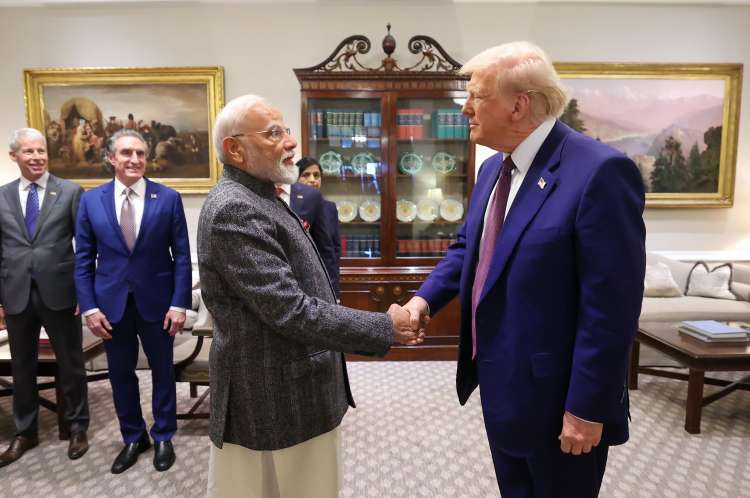President Trump’s sudden tariff threat has jolted the fragile India-US trade talks, but it has not shut them down. On 30 July he wrote on Truth Social that a 25 per cent tariff on India, plus an undefined penalty, from August 1. Trump blames India’s high tariffs and its purchases of Russian oil and weapons. The rupee dipped, exporters re-checked their numbers, and South Block rushed into emergency meetings. Yet a US team is still due in New Delhi later in August for a sixth round of talks. The new duty is, at once, a warning and a bargaining chip.
In Washington today, tariffs are not a last-minute fix; they are the opening move. The White House offers lower rates — Japan and the EU got 15 per cent — to partners willing to open their farm, dairy and car markets. India has refused, noting that the incomes of over 700 million farmers are not up for barter. The 25 per cent barrier is meant to push New Delhi before the US election calendar locks policy. As adviser Kevin Hassett put it, the tariff will remedy the situation unless India yields ground.
READ I US tariffs windfall masks looming crisis for world economy
25 per cent tariff on India a negotiating cudgel
India exported goods worth roughly $118 billion to the US in 2024 — about 17 per cent of total shipments. Internal estimates suggest that a 25 per cent tariff on India exports will bite into only 10 per cent of that basket in the current quarter; gems, jewellery, electronics and some textiles are in the cross‑hairs. Nevertheless, the blow lands precisely where high‑value, high‑employment clusters are concentrated — Surat’s diamond cutters, Noida’s handset assemblers, Tirupur’s knitwear units.
The near‑term macro impact may be limited to 0.1 percentage point of GDP, but the political optics of shuttered factories would overshadow the statistics. In effect, the US is leveraging concentrated pain for maximum pressure while preserving overall bilateral trade momentum.
Agriculture, pharma and digital trade
Talks faltered not for want of ambition but for want of symmetry. Washington insists on deeper access for American dairy, poultry and genetically modified feed — non‑starters for a government already battling farm‑sector unrest. It also presses for lower tariffs on Harley‑Davidsons and larger quotas for US auto firms. New Delhi counters with demands for easier H‑1B visa regimes, recognition of Indian pharmaceutical approvals and protection against draconian digital services taxes aimed at its IT firms.
Each side frames the other’s stance as protectionist, yet neither can cross domestic red lines. The task now is to design carve‑outs—perhaps a tariff‑rate quota for dairy tied to cold‑chain investments, or a phased reduction in bike duties in exchange for a visa‑services package—that save political face while widening commercial space.
The Russia card complicates the chessboard
The nominal trigger for the new levy is India’s energy and defence commerce with Moscow. Since the Ukraine invasion, discounted Ural crude has supplied nearly 40 per cent of India’s oil imports, softening pump prices and headline inflation. Defence contracts with Rosoboronexport are locked in years before delivery; cancelling them would leave strategic gaps at a sensitive time on the China border. Washington knows this, yet raises the issue to justify punitive action and to signal toughness to allies wary of secondary sanctions.
For India, the charge is disingenuous: energy diversification is economic common sense, and legacy Russian platforms are being progressively phased out in favour of US, Israeli and indigenous systems. The Russia angle, therefore, is less about principle than about bargaining leverage.
Can the talks be salvaged
History counsels against despair. The 2019 mini‑deal lost steam after the US election calendar crowded out legislative bandwidth, only to be revived post‑pandemic. The present round still has tail‑winds — US importers want reliable suppliers outside China, Indian firms crave technology tie‑ups, and both capitals need a geopolitical counterweight to Beijing.
The architecture of a phased accord already exists: a narrow first stage covering tariff peaks, followed by sequential modules on services, intellectual‑property enforcement and critical‑minerals supply chains. What is missing is political choreography. A clear, time‑bound roadmap—ideally announced at the upcoming G20 Trade Ministers’ meeting—can reassure investors that the tariff shock is temporary and reversible.
Reset, reform, re‑engage
Pivot to a coalition of the willing: India should convene a “backers of open supply chains” caucus with Japan, Australia, the EU and ASEAN partners similarly exposed to tariff pressure. A collective message on rules‑based trade will raise the diplomatic cost of unilateral US action.
Prepare a conditional offer on agriculture: A calibrated quota for US dairy and poultry — linked to explicit USTR commitments on labour mobility and mutual recognition of pharma standards — can break the logjam without sacrificing farm incomes.
Accelerate domestic tariff rationalisation: Many of India’s applied rates already sit well below bound WTO ceilings. A transparent, time‑bound schedule to align the outliers (especially in electronics) will blunt the criticism of “highest tariffs in the world” and improve consumer welfare at home.
Ring‑fence energy security: New Delhi must articulate a long‑term pathway to reduce Russian oil dependence — expanding Gulf procurement, investing in African upstream assets and fast‑tracking green‑hydrogen projects — so that Washington’s Russia pretext loses salience.
Institutionalise dispute settlement: Reviving the dormant Trade Policy Forum with a ministerial‑level meeting every quarter—and empowering it to invoke neutral arbitration within 30 days of a dispute — would prevent the next tariff spiral.
A narrow window remains before August ends. If both sides move swiftly, India by tabling a creative agriculture‑visa swap, the US by suspending the penalty clause pending progress, the 25 per cent tariff could become a footnote rather than a fracture.
The alternative is a lose‑lose spiral — higher costs for American consumers, lost orders for Indian exporters and diminished strategic trust in the Indo‑Pacific. In a century when supply chains, security and sustainability are interwoven, tariff wars are the bluntest of instruments.

